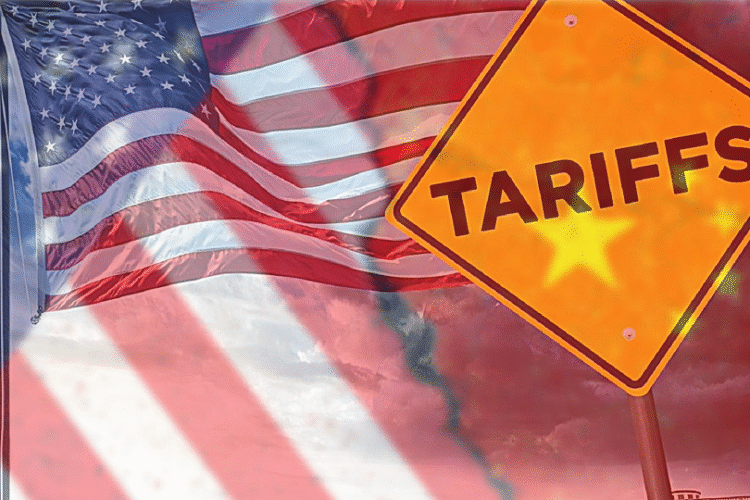The U.S. economy has been the largest in the world for the past five decades, a remarkable achievement based on a unique combination of strengths. However, the recent rise in tariffs could pose new challenges. Let’s explore the reasons behind the U.S.’s success and how these tariffs might disrupt the economy and the stock markets.
The Engine of the Global Economy: Why the U.S. Has Led for 50 Years
Imagine a massive engine that has fueled the world’s economy for generations. It is none other than the United States. Here’s why it has maintained its position as the number one economy for so long:
Sheer Size and Variety:
The U.S. economy is enormous. In 2023, its total output, known as Gross Domestic Product (GDP), was about $27.72 trillion. For comparison, the second largest economy, China, was around $17.79 trillion. This economy isn’t just big; it’s incredibly diversified, ranging between high-tech gadgets and farm produce, financial services, and entertainment. This variety makes it very stable, if one sector slows down, others keep growing. Looking ahead, experts like the IMF predict the U.S. GDP could reach $30.51 trillion by 2025, still well ahead of China’s expected $19.23 trillion.
Smart Ideas and New Businesses (Innovation):
The United States has been a center for new ideas and inventions. Places like Silicon Valley, where companies like Apple and Google were born, show how good the U.S. is at creating new technologies. This is fueled by massive spending on Research & Development (R&D). In 2024, the U.S. spent around a whopping $985 billion on R&D, which is about 3.45% of its entire economic output. This is much higher than many other countries. The U.S. has been consistently finding new ways to do things, making its economy more efficient and creating new jobs. This spending is increasing every year and it is expected to surpass $1 trillion in 2025.
Big Spenders (Consumers):
Imagine a country where everyone has money to buy things, that is the power of United States. The average American generates significant economic value, with a projected GDP per person (per capita) of around $89,105 in 2025. This is much higher than China’s projected GDP of $13,688 per person. All this individual wealth translates into enormous buying power. Consumer spending accounts for a substantial portion of the U.S. economy, typically around 68% to 69% of its GDP. This continuous buying keeps factories busy, stores open, and services running, functioning like a powerful engine.
Global Financial Hub:
The United States has the largest and most liquid stock markets in the world, including the New York Stock Exchange (NYSE) and NASDAQ. Currently, U.S. stock markets accounts for over 50% of the total global stock market value, which is around $62 trillion. This indicates that companies worldwide prefer to list their shares in the United States. Investors globally have confidence in the U.S. financial system. Additionally, the U.S. dollar serves as the world’s primary reserve currency. The countries and businesses across the globe use it for international transactions and savings. This status provides the U.S. with unique financial power and stability.
The Trump’s Tariff Effect: How Recent Taxes on Imports Could Change the Landscape
Recently, the U.S. has implemented tariffs, which are essentially taxes imposed on imported goods. These tariffs are often targeted at countries like China, typically due to disagreements over trade practices. The recent tariffs from late 2024 and early 2025 reflect certain policies. We can analyze previous tariffs from 2018-2019 since their effects often show similar patterns.
Things Get More Expensive:
When the U.S. imposes a tariff on, for example, steel from another country, the price of that steel increases. This added cost is often transferred to American businesses that purchase the steel, and ultimately, to the consumers, when they buy items like cars or new appliances. Researches on past tariffs have shown how American consumers have paid almost the entire cost of tariffs on Chinese goods, resulting in billions of dollars in additional expenses. According to a research article by Federal Reserve Bank of Sanfrancisco, a widespread 25% tariff could increase the price of everyday items by approximately 2.2% for consumption goods and 9.5% for investment goods. One could only imagine the burden on consumers when tariffs exceed 50%, as seen with imports from China.
Supply Chain Issues:
Tariffs disrupt how companies manufacture and deliver their products. If obtaining parts from one country becomes suddenly expensive, companies must search for new suppliers, possibly in different countries. They might attempt to produce the components themselves in the U.S. This process is costly and complicated. It is similar to being forced to build an entirely new delivery road, which takes time and money, and may not be as efficient as the previous route.
Slower Economic Growth:
When the U.S. imposes tariffs on other countries, their governments retaliate with their tariffs on U.S. goods. This scenario, known as a “trade war,” creates significant challenges for U.S. companies trying to sell their products abroad, ultimately harming their profits. Economic models analyzing the 2018-2019 trade war indicate that it could have reduced U.S. economic growth (GDP) by 0.3% to 0.7%. Over the next two years, the likelihood of the US experiencing negative GDP growth is increasingly becoming a reality. For a multi-trillion-dollar economy, this represents billions of dollars in lost opportunities and leads to fewer job openings.
Tariffs and Uncertainty: How Stock Markets React
Stock markets are susceptible to news, and tariffs often send them on a wild ride:
Increased Volatility in Stock Markets:
Stock markets are highly sensitive to uncertainty, and tariffs significantly contribute to this uncertainty. When new tariffs are announced or even threatened, investors become apprehensive about their impact on company profits and the global economy. This often results in dramatic declines in stock prices. For example, in early April 2025, fears regarding new tariff regimes led to a substantial drop of 20% from its highs in the S&P 500 index. The crash had erased trillions of dollars in value. Once the tensions were alleviated and tariffs were paused until 9th July, the markets rebounded rapidly on the expectations of trade deals between the U.S. and trade partners. This short and steep rally in April and May have recovered most of the losses. This volatility makes investing riskier and less predictable.
Company Profits Take a Hit:
Tariffs have a significant effect on company profits. When a U.S. company relies on imported parts that become more expensive due to tariffs, its costs increase, leading to reduced profits. Similarly, if a U.S. company exports products to other countries and those nations impose tariffs on those products, it becomes more difficult to sell them. This results in lower revenue and decreased profits. According to Goldman Sachs, for every 5% increase in U.S. tariff rates, the earnings per share for companies in the S&P 500 could decrease by 1% to 2%. Consequently, this makes investors less interested in purchasing their stocks.
Some Companies Face more Challenges:
Not all companies experience the same level of impact. Businesses such as Amazon and Walmart, with extensive export operations that rely heavily on global supply chains are among the hardest hit. The companies manufacturing electronics like Apple or automobile manufacturers like Ford and GM also suffer the most. In contrast, companies that primarily sell within the U.S. and rely less on imports like Regional Banks, Utilities, and Healthcare Providers may be less affected. These companies might even benefit if their foreign competitors face high tariffs. As a result, investors often adjust their portfolios, moving their money to avoid these sectors.
Overall Investor Caution:
The current situation is highly uncertain with looming economic recessions driven by new tariffs, a concerning rise in U.S. Treasury yields, and the ever-growing national debt now exceeding $36 trillion. Despite these challenges, investors appear overly confident, likely due to psychological biases, and are ignoring the impending economic crisis. Major indices such as S&P 500, Nasdaq 100, Nifty 50, and Nikkei 225 are currently hovering around 5% to 10% from their all-time highs, and technical charts suggest they are performing strongly.
An immediate decline in the stock markets is unlikely. Investors usually require a combination of rising inflation, increasing unemployment, declining corporate earnings, or an economic downturn to fully reassess their positions. When trade wars escalate and economic crises deepen, investors tend to be more cautious. They may withdraw their funds from risky investments, such as stocks, and shift them into safer options like government bonds or gold at a rapid rate. This “risk-off” sentiment can lead to a stock market correction or even a crash, depending on how severe the crisis becomes.
Conclusion
In summary, while the strengths of the U.S. economy have remained strong for decades, tariffs introduce a range of complex challenges. The tariffs can increase prices, complicate business operations, and potentially hinder growth. As a result, stock markets may experience greater instability, reduced company profits, and a general sense of caution, making investing more unpredictable. The future of the U.S. and the global economy will depend on how well countries work together, leveraging their inherent strengths alongside the impacts of modern trade measures.
Links used for reference:
- How tariffs are forecast to affect US stocks
- Chinese Apple supplier stocks drop after Trump’s tariffs threats
- Ford Says Tariffs To Have A $1.5 Billion Impact, Halts Full Year Outlook
- The Effects of Tariffs on Inflation and Production Costs
Disclaimer:
I provide the information and my views on the website only to educate people, new investors, and stock market enthusiasts on equity and other market investments. Please consult a SEBI registered financial advisor before making any investments in the stock or commodity markets. In case of any queries, you can contact me on Contact Form or email: admin@valueinvestingonline.in.




